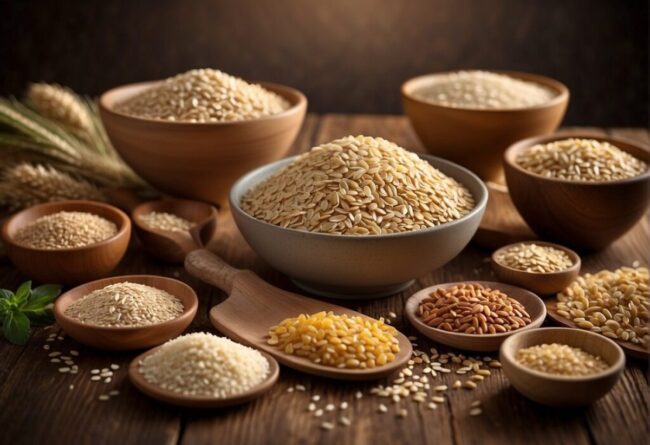3 Affordable Ways to Swap Kamut in Recipes
Kamut substitutes keep recipes hearty and nutritious when this ancient grain isn’t available.
Some grains match its chewy texture, while others bring a softer, fluffier quality.
The right swap ensures dishes remain satisfying without changing their natural richness.
Cooking with a well-matched alternative keeps the meal just as filling.
What to Know About Kamut
Kamut is an ancient grain known for its nutty flavor and high protein content. It is often used in bread, pasta, and salads.
Kamut’s Health Benefits
Kamut stands out for its impressive nutritional profile, offering more protein than many conventional grains.
Packed with fiber, it plays a crucial role in promoting digestive wellness.
The presence of magnesium and zinc supports overall health and strengthens the immune system.
Rich in iron and selenium, this ancient grain enhances blood health while providing antioxidant benefits.
With B vitamins like riboflavin and niacin included, Kamut fuels your energy levels throughout the day seamlessly.
Kamut for Cooking and Baking
Kamut flour stands out for its distinctive nutty flavor and robust texture.
Breads, cakes, and cookies take on a delightful chewiness that makes each bite satisfying.
This flour adapts beautifully in both baking and cooking, allowing you to experiment with various dishes beyond the traditional sweets.
Its unique taste enhances recipes, elevating even the simplest meals into something memorable.
When you incorporate kamut into your kitchen adventures, expect a whole new level of culinary creativity to unfold before you.
Gluten’s Role in Kamut
Kamut offers a rich, nutty flavor that elevates various dishes.
This ancient grain holds gluten, giving it an elastic quality that enhances the texture of baked goods.
The structural integrity it provides ensures your creations look as good as they taste.
When considering substitutes for Kamut, take note of how they may change both nutritional aspects and gluten levels in your meals.
Always keep dietary restrictions in mind when experimenting with alternatives to maintain balance in your cooking.
Alternatives to Kamut Grain
Kamut grain offers a unique flavor and nutritional profile, but alternatives exist for those seeking variety. You'll find several options to provide similar textures and health benefits below.
Gluten-Free Options
Celiac disease and gluten sensitivities shouldn't limit your food options.
Quinoa stands out as a powerhouse, delivering all essential amino acids in every serving.
Amaranth surprises with its high fiber content and a delightful texture that many appreciate when cooked.
Buckwheat, despite the name confusion, offers an impressive magnesium boost while keeping meals gluten-free.
Teff packs a nutritional punch in its tiny grains, perfect for adding to baked goods or porridge.
Rice remains accessible and versatile for various recipes while providing simplicity without any gluten concerns.
Wheat Alternatives
Exploring gluten-friendly alternatives can open up a world of flavor and nutrition.
Spelt flour stands out with its nutty taste, making it perfect for hearty breads and delicious pastas.
Whole-wheat flour is a reliable choice that enhances fiber intake while delivering classic baking results.
Farro, an ancient grain, adds a delightful chewiness to salads or bowls while packing essential vitamins and minerals.
Einkorn flour offers an intriguing twist with its elevated protein and fat content, appealing to those seeking nutritious options in their meals.
Nature and Nutrition of Alternatives
Exploring substitutes for kamut opens up a world of nutritional diversity.
Ancient grains like quinoa and amaranth shine with higher protein content and essential minerals, offering a nutritious boost to meals.
Wheat-based options such as spelt and einkorn are fiber-rich, contributing positively to digestive health.
Gluten-free choices hold significant importance for individuals with celiac disease or gluten sensitivity, ensuring everyone can enjoy wholesome grains.
Whole grains like farro and barley not only add depth to dishes but also support long-term health by potentially reducing chronic disease risks; it’s all about finding what fits your lifestyle best!
Comparing Kamut to Other Grains
Comparing Kamut to other grains highlights its rich texture and nutritional value. It serves as a great alternative to wheat in various recipes.
Kamut Uses and Alternatives
Kamut grain delivers a delightful, nutty taste that enhances both baking and cooking.
Its buttery texture makes it an excellent choice for creating pastas and breads that are satisfying to eat.
Spelt flour can be swapped in for a hint of sweetness while maintaining a similar taste profile, perfect for various baked goods.
Farro brings an enjoyable chewiness to soups and salads, adding depth with its robust flavor.
Quinoa's neutral flavor allows it to fit seamlessly into numerous dishes like casseroles or salads without overpowering other ingredients, while barley's chewy bite complements stews beautifully and works well in risottos when hulled.
Food Nutrition Comparison
Kamut offers a remarkable nutritional profile that stands out among grains.
Its rich protein and fiber content supports overall health, making it a fantastic choice for those looking to enhance their diet.
This ancient grain contains essential vitamins and minerals that contribute significantly to well-being, often surpassing modern wheat flours in these areas.
While gluten-free options like quinoa exist for those with dietary restrictions, Kamut remains a powerful option packed with nutrients.
Choosing Kamut can elevate your meals while providing benefits that are hard to overlook.

